Business Research: Human Ethics Case Study on Work Life Balance
VerifiedAdded on 2022/10/08
|10
|1862
|13
Case Study
AI Summary
This case study delves into the ethical considerations of researching work-life balance within an organizational context. The student's project aims to explore employees' perceptions of work-life balance, encompassing their personal interests, social lives, family commitments, leisure activities, and professional responsibilities. The research methodology involves qualitative and quantitative approaches, utilizing primary data collection through individual interviews and written questionnaires with approximately 50 participants. Ethical considerations are central, emphasizing equality, random selection, and unbiased data interpretation. The study addresses participant recruitment strategies, including internal staff recruitment, and emphasizes informed consent, outlining the risks, such as potential breaches of confidentiality, and mitigation strategies. The data collection process focuses on individual interviews to gather unbiased responses. The conclusion reiterates the ethical framework and research scope, highlighting the importance of work-life balance and the participants involved. The research also includes the participants details, recruitment methods, risks involved, and data collection methods. This case study provides insights into ethical research practices and the significance of work-life balance in organizational management.
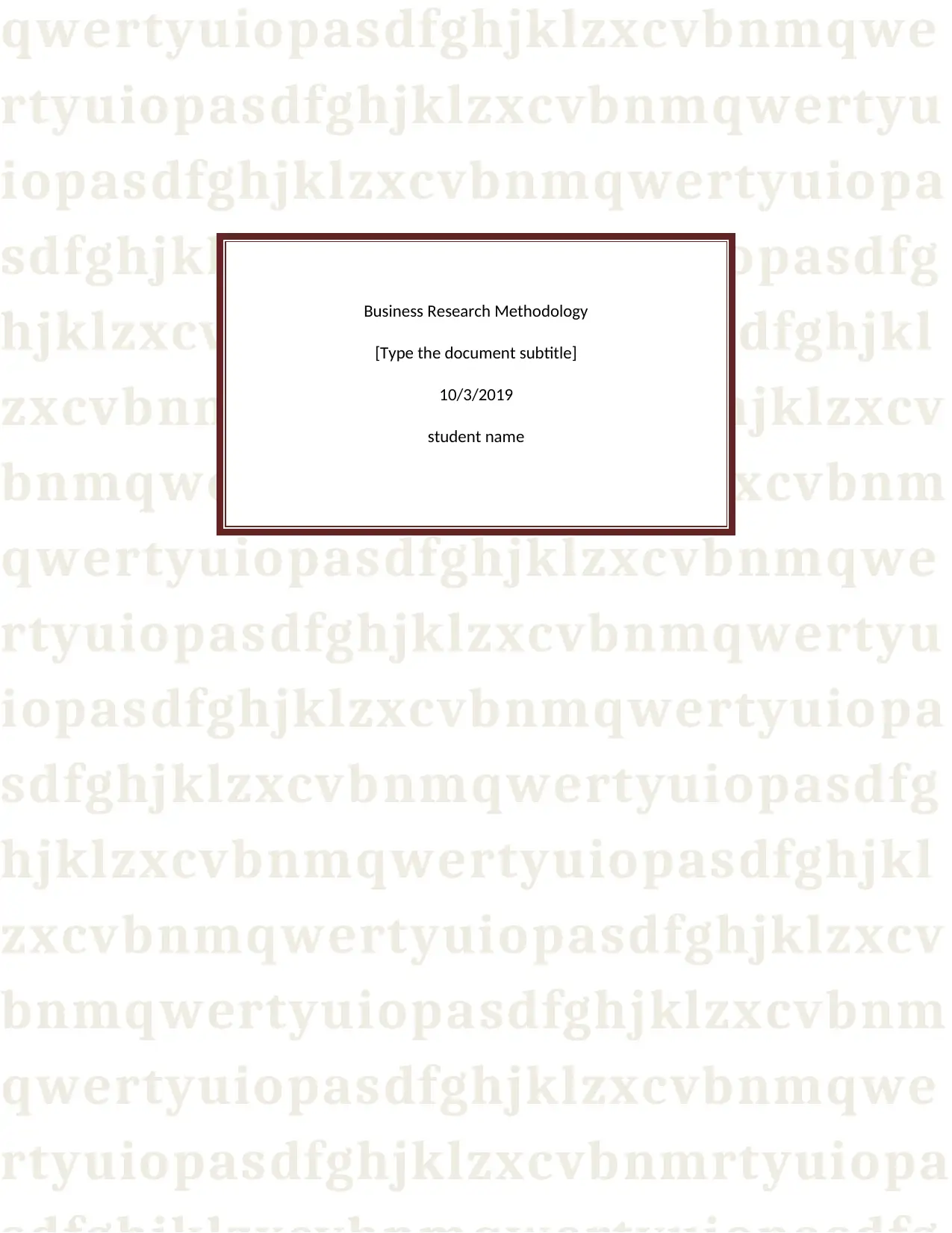
qwertyuiopasdfghjklzxcvbnmqwe
rtyuiopasdfghjklzxcvbnmqwertyu
iopasdfghjklzxcvbnmqwertyuiopa
sdfghjklzxcvbnmqwertyuiopasdfg
hjklzxcvbnmqwertyuiopasdfghjkl
zxcvbnmqwertyuiopasdfghjklzxcv
bnmqwertyuiopasdfghjklzxcvbnm
qwertyuiopasdfghjklzxcvbnmqwe
rtyuiopasdfghjklzxcvbnmqwertyu
iopasdfghjklzxcvbnmqwertyuiopa
sdfghjklzxcvbnmqwertyuiopasdfg
hjklzxcvbnmqwertyuiopasdfghjkl
zxcvbnmqwertyuiopasdfghjklzxcv
bnmqwertyuiopasdfghjklzxcvbnm
qwertyuiopasdfghjklzxcvbnmqwe
rtyuiopasdfghjklzxcvbnmrtyuiopa
Business Research Methodology
[Type the document subtitle]
10/3/2019
student name
rtyuiopasdfghjklzxcvbnmqwertyu
iopasdfghjklzxcvbnmqwertyuiopa
sdfghjklzxcvbnmqwertyuiopasdfg
hjklzxcvbnmqwertyuiopasdfghjkl
zxcvbnmqwertyuiopasdfghjklzxcv
bnmqwertyuiopasdfghjklzxcvbnm
qwertyuiopasdfghjklzxcvbnmqwe
rtyuiopasdfghjklzxcvbnmqwertyu
iopasdfghjklzxcvbnmqwertyuiopa
sdfghjklzxcvbnmqwertyuiopasdfg
hjklzxcvbnmqwertyuiopasdfghjkl
zxcvbnmqwertyuiopasdfghjklzxcv
bnmqwertyuiopasdfghjklzxcvbnm
qwertyuiopasdfghjklzxcvbnmqwe
rtyuiopasdfghjklzxcvbnmrtyuiopa
Business Research Methodology
[Type the document subtitle]
10/3/2019
student name
Paraphrase This Document
Need a fresh take? Get an instant paraphrase of this document with our AI Paraphraser
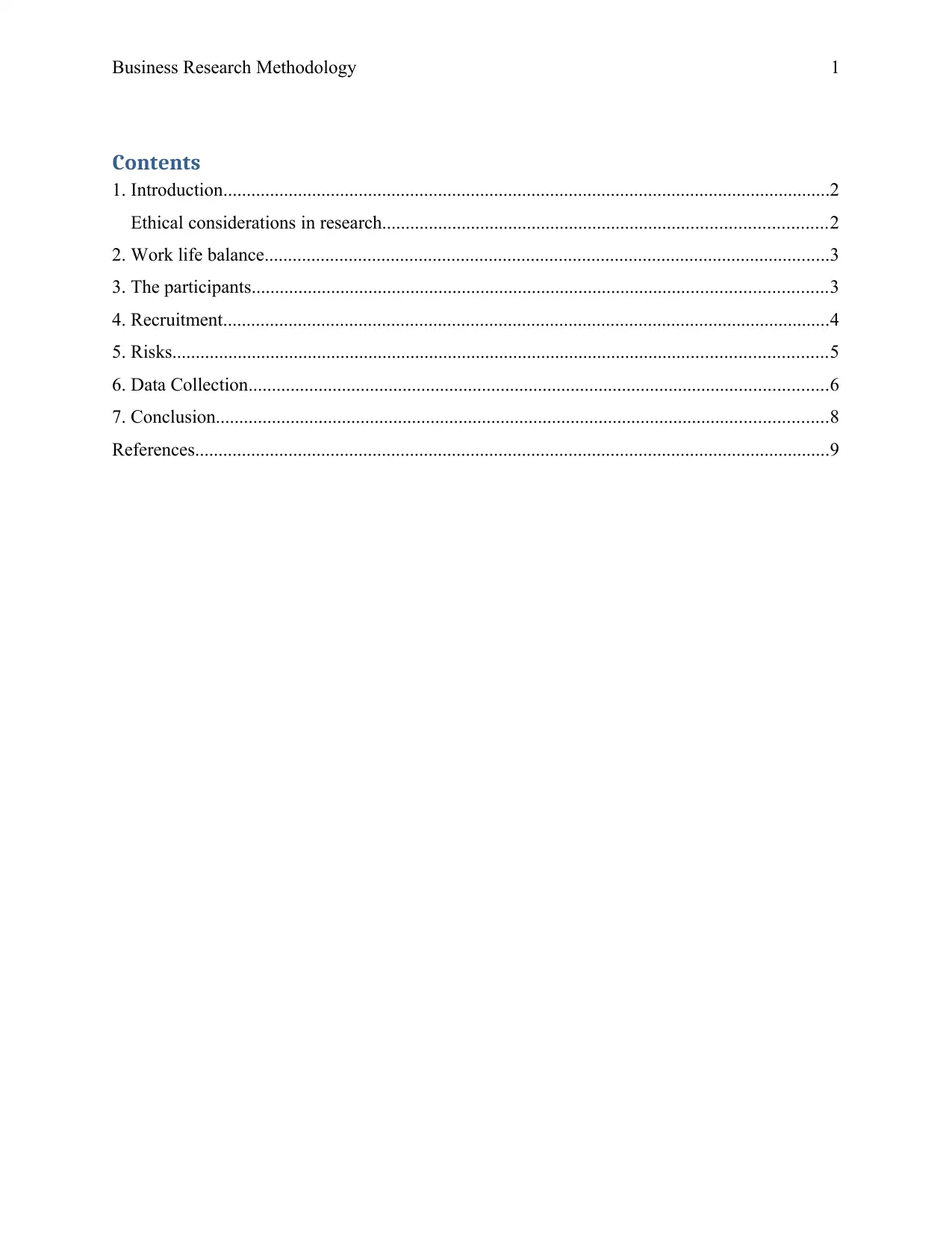
Business Research Methodology 1
Contents
1. Introduction..................................................................................................................................2
Ethical considerations in research...............................................................................................2
2. Work life balance.........................................................................................................................3
3. The participants...........................................................................................................................3
4. Recruitment..................................................................................................................................4
5. Risks............................................................................................................................................5
6. Data Collection............................................................................................................................6
7. Conclusion...................................................................................................................................8
References........................................................................................................................................9
Contents
1. Introduction..................................................................................................................................2
Ethical considerations in research...............................................................................................2
2. Work life balance.........................................................................................................................3
3. The participants...........................................................................................................................3
4. Recruitment..................................................................................................................................4
5. Risks............................................................................................................................................5
6. Data Collection............................................................................................................................6
7. Conclusion...................................................................................................................................8
References........................................................................................................................................9
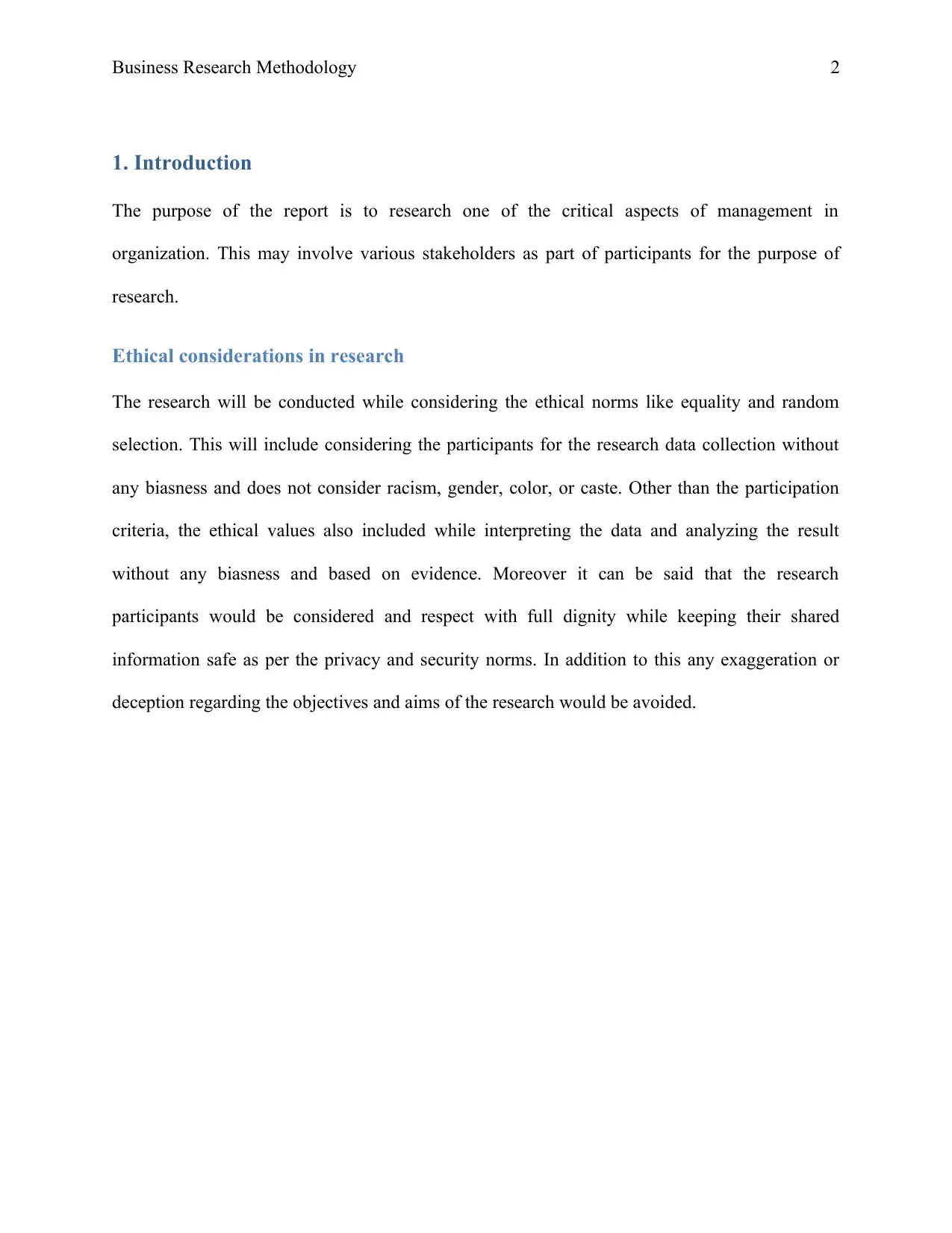
Business Research Methodology 2
1. Introduction
The purpose of the report is to research one of the critical aspects of management in
organization. This may involve various stakeholders as part of participants for the purpose of
research.
Ethical considerations in research
The research will be conducted while considering the ethical norms like equality and random
selection. This will include considering the participants for the research data collection without
any biasness and does not consider racism, gender, color, or caste. Other than the participation
criteria, the ethical values also included while interpreting the data and analyzing the result
without any biasness and based on evidence. Moreover it can be said that the research
participants would be considered and respect with full dignity while keeping their shared
information safe as per the privacy and security norms. In addition to this any exaggeration or
deception regarding the objectives and aims of the research would be avoided.
1. Introduction
The purpose of the report is to research one of the critical aspects of management in
organization. This may involve various stakeholders as part of participants for the purpose of
research.
Ethical considerations in research
The research will be conducted while considering the ethical norms like equality and random
selection. This will include considering the participants for the research data collection without
any biasness and does not consider racism, gender, color, or caste. Other than the participation
criteria, the ethical values also included while interpreting the data and analyzing the result
without any biasness and based on evidence. Moreover it can be said that the research
participants would be considered and respect with full dignity while keeping their shared
information safe as per the privacy and security norms. In addition to this any exaggeration or
deception regarding the objectives and aims of the research would be avoided.
⊘ This is a preview!⊘
Do you want full access?
Subscribe today to unlock all pages.

Trusted by 1+ million students worldwide
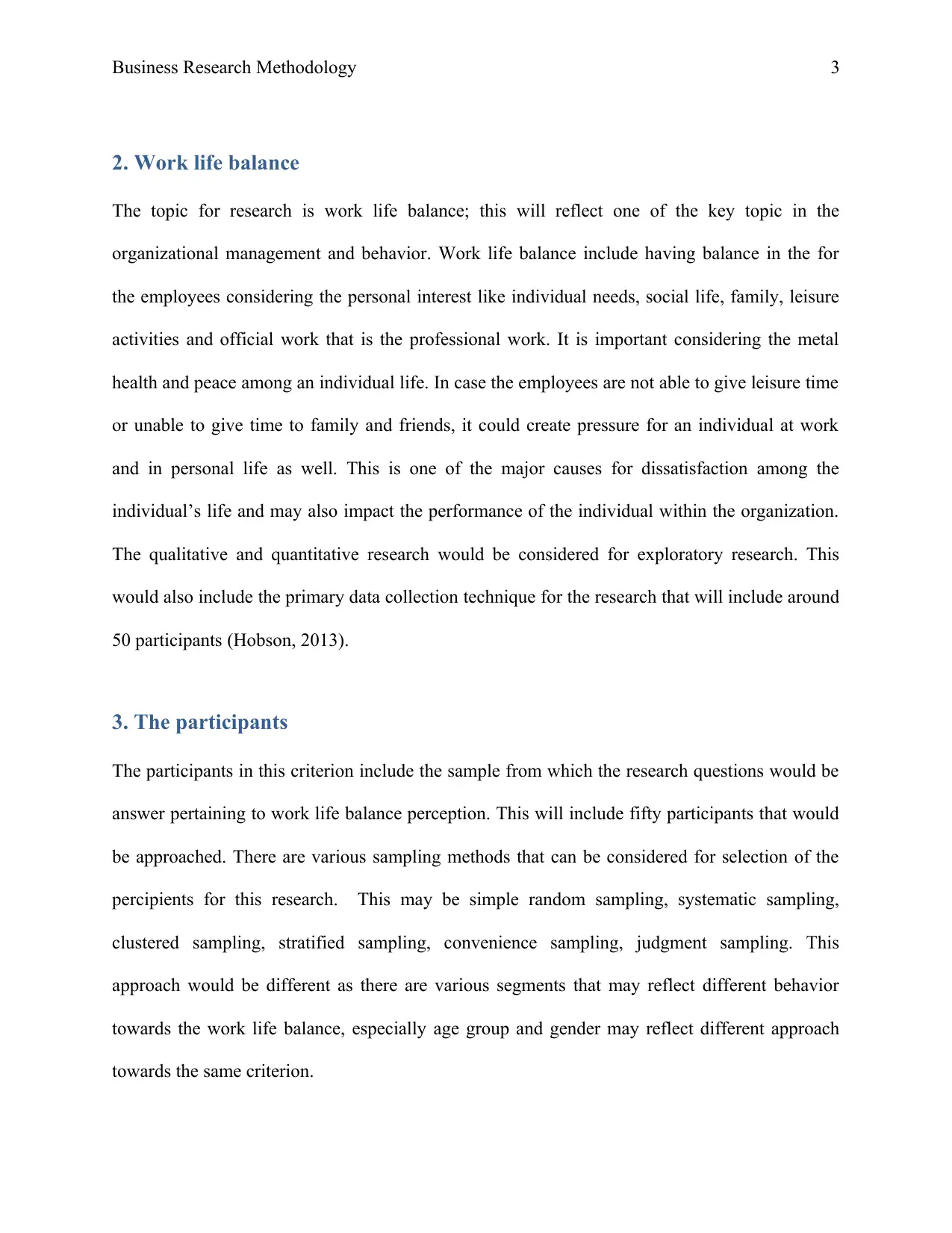
Business Research Methodology 3
2. Work life balance
The topic for research is work life balance; this will reflect one of the key topic in the
organizational management and behavior. Work life balance include having balance in the for
the employees considering the personal interest like individual needs, social life, family, leisure
activities and official work that is the professional work. It is important considering the metal
health and peace among an individual life. In case the employees are not able to give leisure time
or unable to give time to family and friends, it could create pressure for an individual at work
and in personal life as well. This is one of the major causes for dissatisfaction among the
individual’s life and may also impact the performance of the individual within the organization.
The qualitative and quantitative research would be considered for exploratory research. This
would also include the primary data collection technique for the research that will include around
50 participants (Hobson, 2013).
3. The participants
The participants in this criterion include the sample from which the research questions would be
answer pertaining to work life balance perception. This will include fifty participants that would
be approached. There are various sampling methods that can be considered for selection of the
percipients for this research. This may be simple random sampling, systematic sampling,
clustered sampling, stratified sampling, convenience sampling, judgment sampling. This
approach would be different as there are various segments that may reflect different behavior
towards the work life balance, especially age group and gender may reflect different approach
towards the same criterion.
2. Work life balance
The topic for research is work life balance; this will reflect one of the key topic in the
organizational management and behavior. Work life balance include having balance in the for
the employees considering the personal interest like individual needs, social life, family, leisure
activities and official work that is the professional work. It is important considering the metal
health and peace among an individual life. In case the employees are not able to give leisure time
or unable to give time to family and friends, it could create pressure for an individual at work
and in personal life as well. This is one of the major causes for dissatisfaction among the
individual’s life and may also impact the performance of the individual within the organization.
The qualitative and quantitative research would be considered for exploratory research. This
would also include the primary data collection technique for the research that will include around
50 participants (Hobson, 2013).
3. The participants
The participants in this criterion include the sample from which the research questions would be
answer pertaining to work life balance perception. This will include fifty participants that would
be approached. There are various sampling methods that can be considered for selection of the
percipients for this research. This may be simple random sampling, systematic sampling,
clustered sampling, stratified sampling, convenience sampling, judgment sampling. This
approach would be different as there are various segments that may reflect different behavior
towards the work life balance, especially age group and gender may reflect different approach
towards the same criterion.
Paraphrase This Document
Need a fresh take? Get an instant paraphrase of this document with our AI Paraphraser
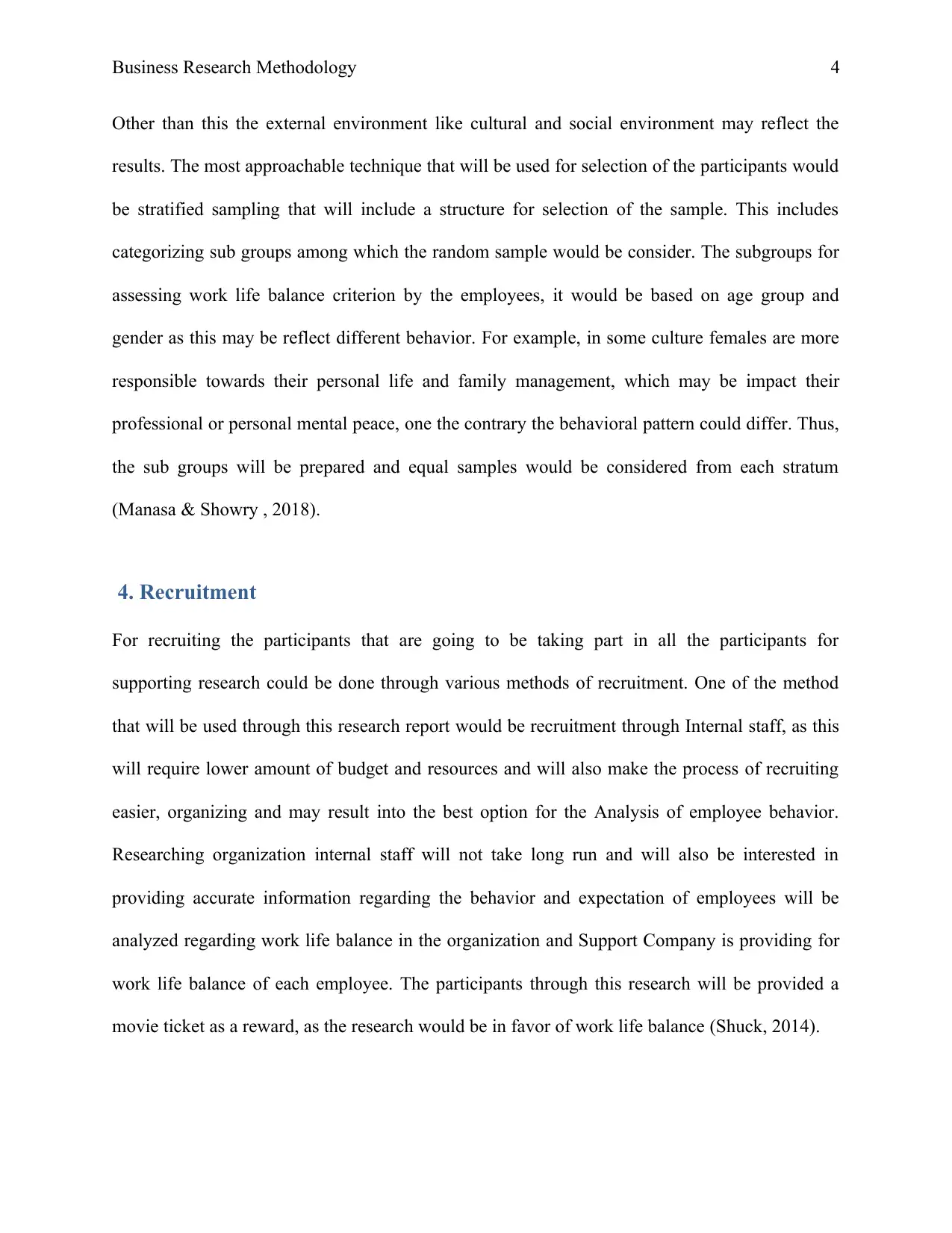
Business Research Methodology 4
Other than this the external environment like cultural and social environment may reflect the
results. The most approachable technique that will be used for selection of the participants would
be stratified sampling that will include a structure for selection of the sample. This includes
categorizing sub groups among which the random sample would be consider. The subgroups for
assessing work life balance criterion by the employees, it would be based on age group and
gender as this may be reflect different behavior. For example, in some culture females are more
responsible towards their personal life and family management, which may be impact their
professional or personal mental peace, one the contrary the behavioral pattern could differ. Thus,
the sub groups will be prepared and equal samples would be considered from each stratum
(Manasa & Showry , 2018).
4. Recruitment
For recruiting the participants that are going to be taking part in all the participants for
supporting research could be done through various methods of recruitment. One of the method
that will be used through this research report would be recruitment through Internal staff, as this
will require lower amount of budget and resources and will also make the process of recruiting
easier, organizing and may result into the best option for the Analysis of employee behavior.
Researching organization internal staff will not take long run and will also be interested in
providing accurate information regarding the behavior and expectation of employees will be
analyzed regarding work life balance in the organization and Support Company is providing for
work life balance of each employee. The participants through this research will be provided a
movie ticket as a reward, as the research would be in favor of work life balance (Shuck, 2014).
Other than this the external environment like cultural and social environment may reflect the
results. The most approachable technique that will be used for selection of the participants would
be stratified sampling that will include a structure for selection of the sample. This includes
categorizing sub groups among which the random sample would be consider. The subgroups for
assessing work life balance criterion by the employees, it would be based on age group and
gender as this may be reflect different behavior. For example, in some culture females are more
responsible towards their personal life and family management, which may be impact their
professional or personal mental peace, one the contrary the behavioral pattern could differ. Thus,
the sub groups will be prepared and equal samples would be considered from each stratum
(Manasa & Showry , 2018).
4. Recruitment
For recruiting the participants that are going to be taking part in all the participants for
supporting research could be done through various methods of recruitment. One of the method
that will be used through this research report would be recruitment through Internal staff, as this
will require lower amount of budget and resources and will also make the process of recruiting
easier, organizing and may result into the best option for the Analysis of employee behavior.
Researching organization internal staff will not take long run and will also be interested in
providing accurate information regarding the behavior and expectation of employees will be
analyzed regarding work life balance in the organization and Support Company is providing for
work life balance of each employee. The participants through this research will be provided a
movie ticket as a reward, as the research would be in favor of work life balance (Shuck, 2014).
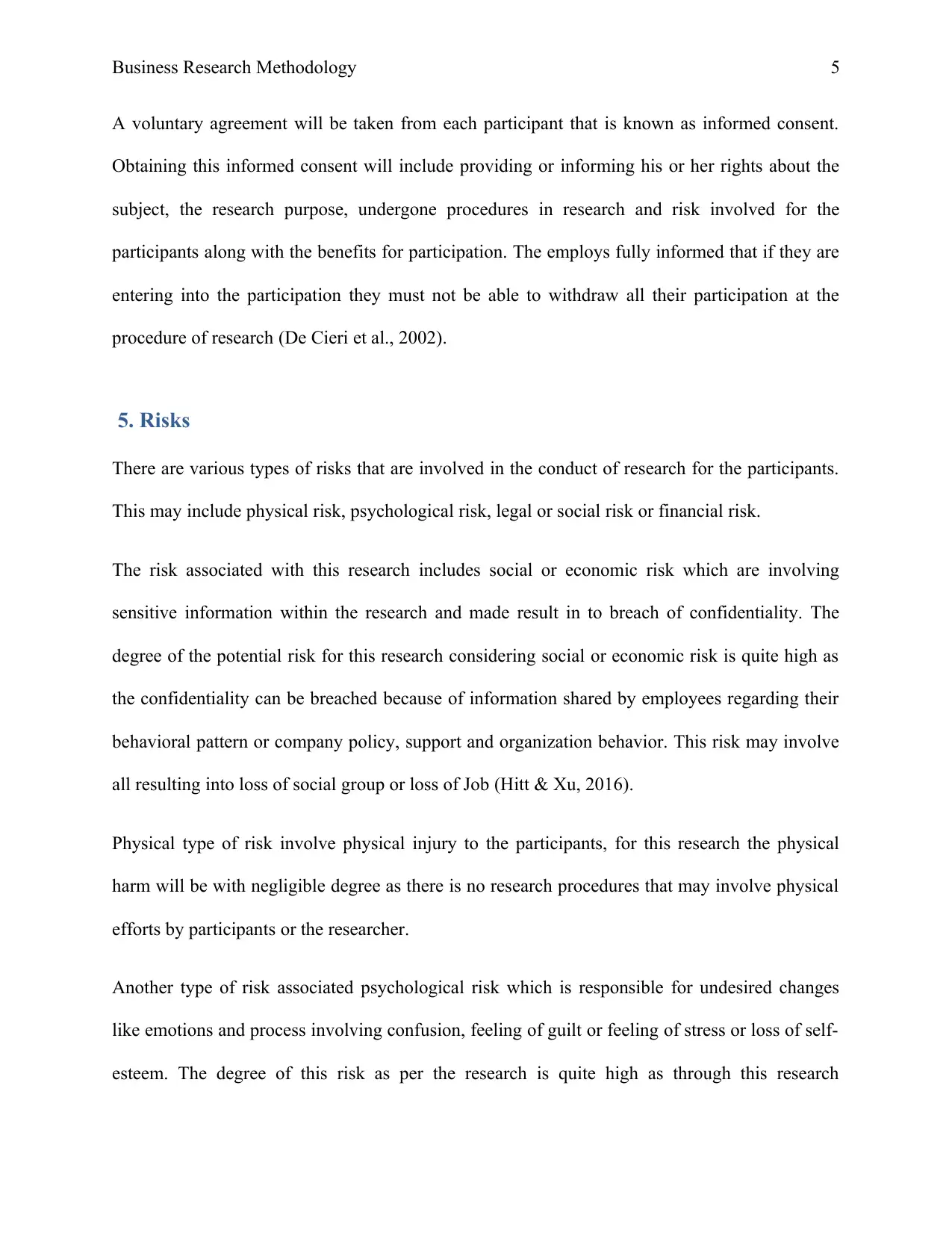
Business Research Methodology 5
A voluntary agreement will be taken from each participant that is known as informed consent.
Obtaining this informed consent will include providing or informing his or her rights about the
subject, the research purpose, undergone procedures in research and risk involved for the
participants along with the benefits for participation. The employs fully informed that if they are
entering into the participation they must not be able to withdraw all their participation at the
procedure of research (De Cieri et al., 2002).
5. Risks
There are various types of risks that are involved in the conduct of research for the participants.
This may include physical risk, psychological risk, legal or social risk or financial risk.
The risk associated with this research includes social or economic risk which are involving
sensitive information within the research and made result in to breach of confidentiality. The
degree of the potential risk for this research considering social or economic risk is quite high as
the confidentiality can be breached because of information shared by employees regarding their
behavioral pattern or company policy, support and organization behavior. This risk may involve
all resulting into loss of social group or loss of Job (Hitt & Xu, 2016).
Physical type of risk involve physical injury to the participants, for this research the physical
harm will be with negligible degree as there is no research procedures that may involve physical
efforts by participants or the researcher.
Another type of risk associated psychological risk which is responsible for undesired changes
like emotions and process involving confusion, feeling of guilt or feeling of stress or loss of self-
esteem. The degree of this risk as per the research is quite high as through this research
A voluntary agreement will be taken from each participant that is known as informed consent.
Obtaining this informed consent will include providing or informing his or her rights about the
subject, the research purpose, undergone procedures in research and risk involved for the
participants along with the benefits for participation. The employs fully informed that if they are
entering into the participation they must not be able to withdraw all their participation at the
procedure of research (De Cieri et al., 2002).
5. Risks
There are various types of risks that are involved in the conduct of research for the participants.
This may include physical risk, psychological risk, legal or social risk or financial risk.
The risk associated with this research includes social or economic risk which are involving
sensitive information within the research and made result in to breach of confidentiality. The
degree of the potential risk for this research considering social or economic risk is quite high as
the confidentiality can be breached because of information shared by employees regarding their
behavioral pattern or company policy, support and organization behavior. This risk may involve
all resulting into loss of social group or loss of Job (Hitt & Xu, 2016).
Physical type of risk involve physical injury to the participants, for this research the physical
harm will be with negligible degree as there is no research procedures that may involve physical
efforts by participants or the researcher.
Another type of risk associated psychological risk which is responsible for undesired changes
like emotions and process involving confusion, feeling of guilt or feeling of stress or loss of self-
esteem. The degree of this risk as per the research is quite high as through this research
⊘ This is a preview!⊘
Do you want full access?
Subscribe today to unlock all pages.

Trusted by 1+ million students worldwide
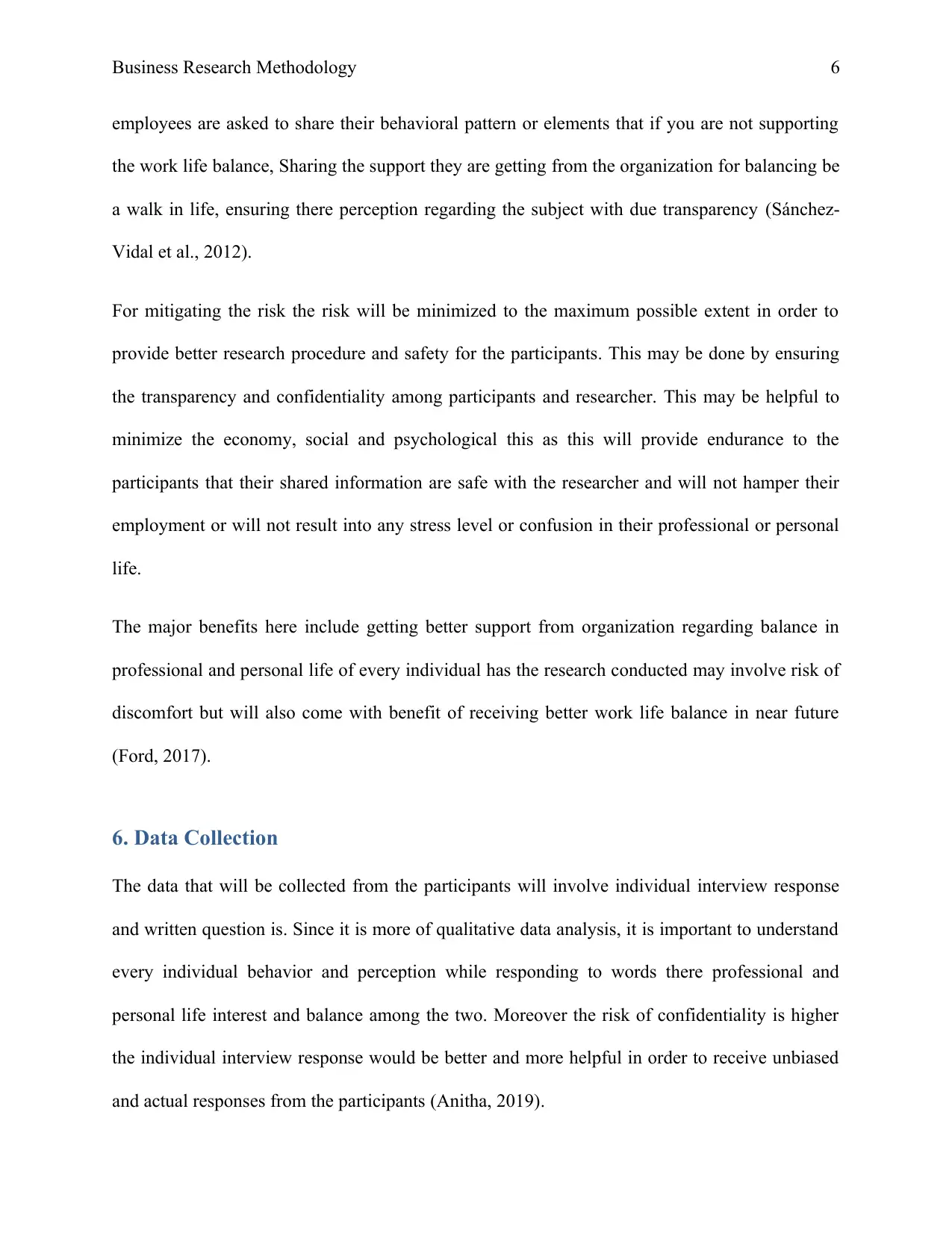
Business Research Methodology 6
employees are asked to share their behavioral pattern or elements that if you are not supporting
the work life balance, Sharing the support they are getting from the organization for balancing be
a walk in life, ensuring there perception regarding the subject with due transparency (Sánchez-
Vidal et al., 2012).
For mitigating the risk the risk will be minimized to the maximum possible extent in order to
provide better research procedure and safety for the participants. This may be done by ensuring
the transparency and confidentiality among participants and researcher. This may be helpful to
minimize the economy, social and psychological this as this will provide endurance to the
participants that their shared information are safe with the researcher and will not hamper their
employment or will not result into any stress level or confusion in their professional or personal
life.
The major benefits here include getting better support from organization regarding balance in
professional and personal life of every individual has the research conducted may involve risk of
discomfort but will also come with benefit of receiving better work life balance in near future
(Ford, 2017).
6. Data Collection
The data that will be collected from the participants will involve individual interview response
and written question is. Since it is more of qualitative data analysis, it is important to understand
every individual behavior and perception while responding to words there professional and
personal life interest and balance among the two. Moreover the risk of confidentiality is higher
the individual interview response would be better and more helpful in order to receive unbiased
and actual responses from the participants (Anitha, 2019).
employees are asked to share their behavioral pattern or elements that if you are not supporting
the work life balance, Sharing the support they are getting from the organization for balancing be
a walk in life, ensuring there perception regarding the subject with due transparency (Sánchez-
Vidal et al., 2012).
For mitigating the risk the risk will be minimized to the maximum possible extent in order to
provide better research procedure and safety for the participants. This may be done by ensuring
the transparency and confidentiality among participants and researcher. This may be helpful to
minimize the economy, social and psychological this as this will provide endurance to the
participants that their shared information are safe with the researcher and will not hamper their
employment or will not result into any stress level or confusion in their professional or personal
life.
The major benefits here include getting better support from organization regarding balance in
professional and personal life of every individual has the research conducted may involve risk of
discomfort but will also come with benefit of receiving better work life balance in near future
(Ford, 2017).
6. Data Collection
The data that will be collected from the participants will involve individual interview response
and written question is. Since it is more of qualitative data analysis, it is important to understand
every individual behavior and perception while responding to words there professional and
personal life interest and balance among the two. Moreover the risk of confidentiality is higher
the individual interview response would be better and more helpful in order to receive unbiased
and actual responses from the participants (Anitha, 2019).
Paraphrase This Document
Need a fresh take? Get an instant paraphrase of this document with our AI Paraphraser
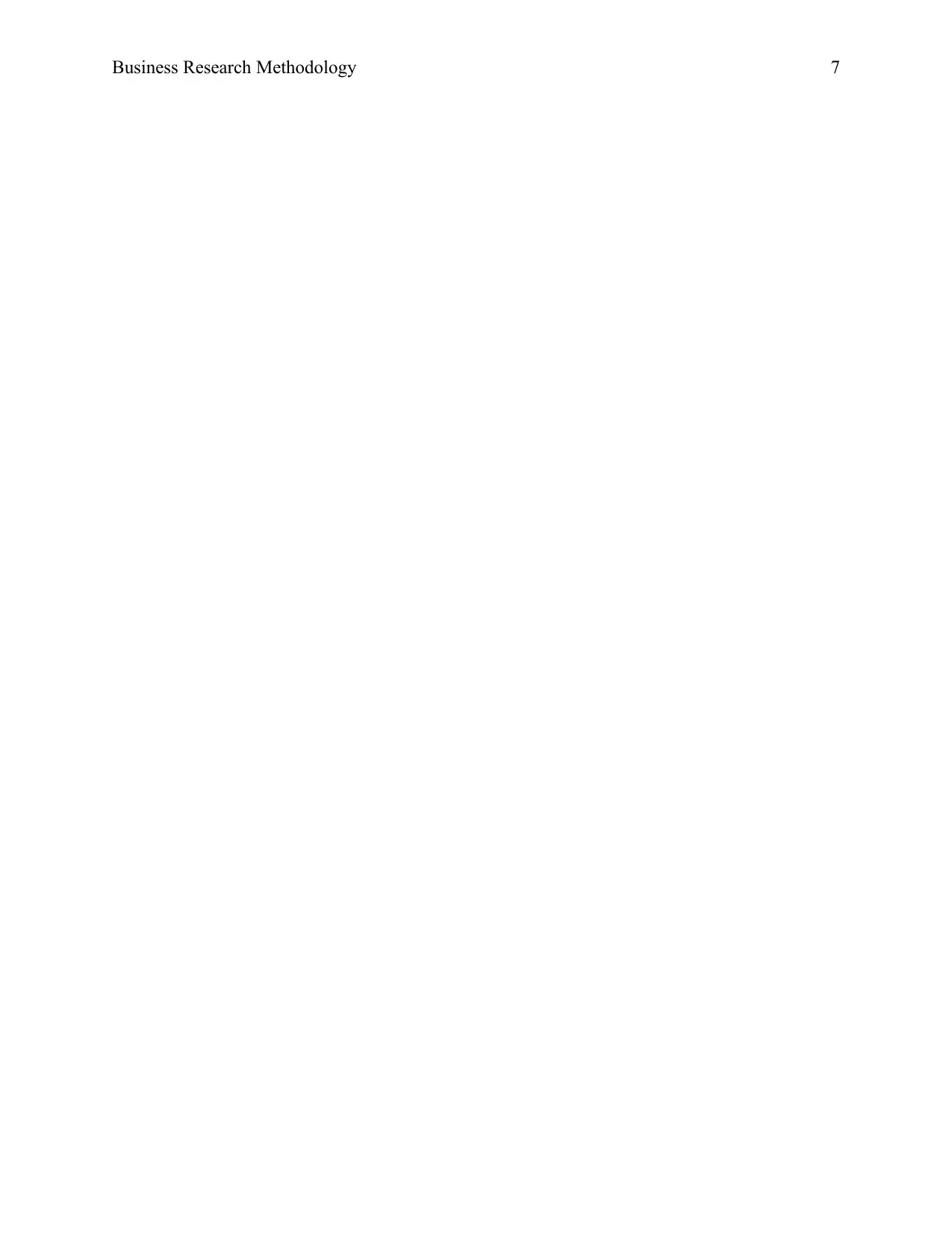
Business Research Methodology 7
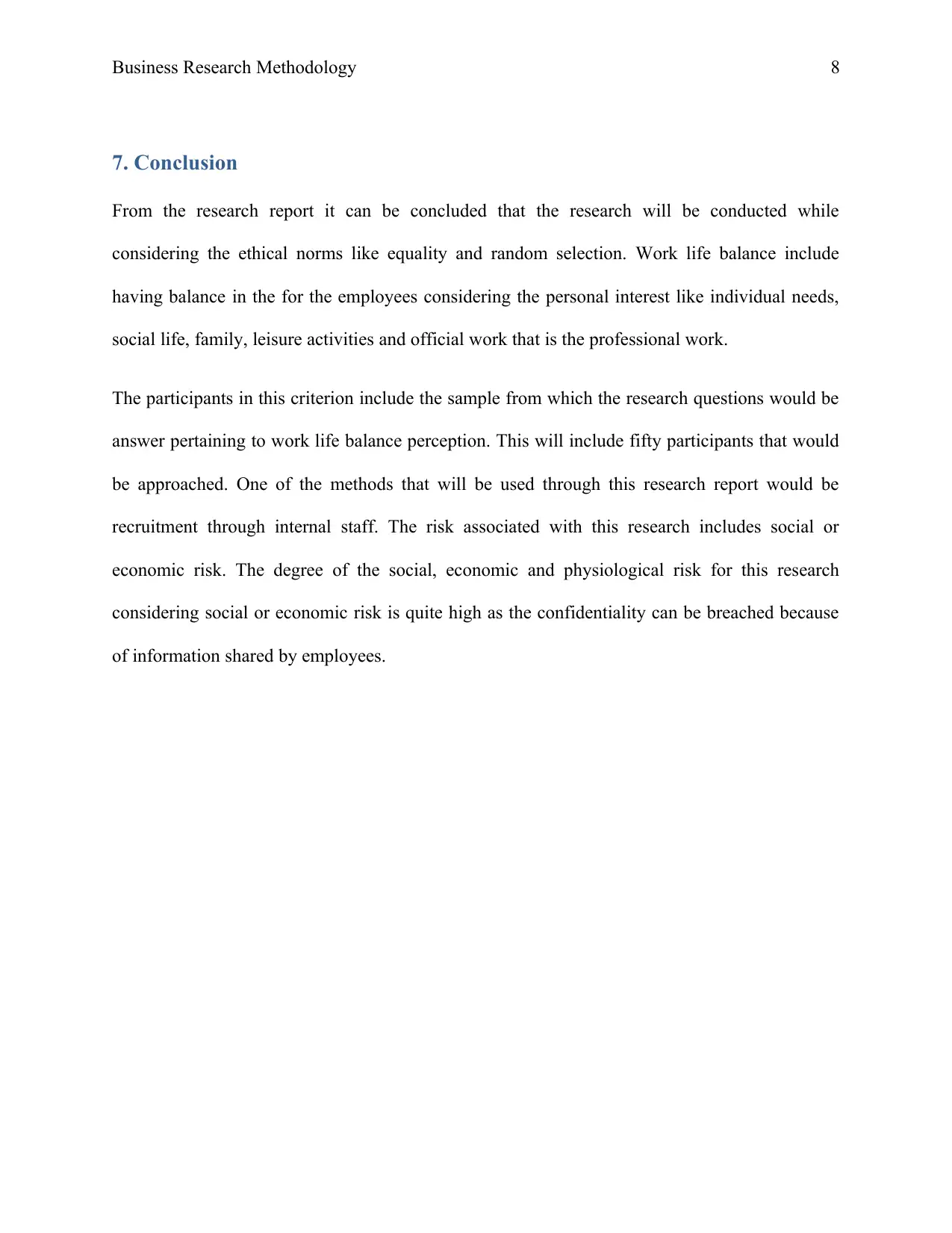
Business Research Methodology 8
7. Conclusion
From the research report it can be concluded that the research will be conducted while
considering the ethical norms like equality and random selection. Work life balance include
having balance in the for the employees considering the personal interest like individual needs,
social life, family, leisure activities and official work that is the professional work.
The participants in this criterion include the sample from which the research questions would be
answer pertaining to work life balance perception. This will include fifty participants that would
be approached. One of the methods that will be used through this research report would be
recruitment through internal staff. The risk associated with this research includes social or
economic risk. The degree of the social, economic and physiological risk for this research
considering social or economic risk is quite high as the confidentiality can be breached because
of information shared by employees.
7. Conclusion
From the research report it can be concluded that the research will be conducted while
considering the ethical norms like equality and random selection. Work life balance include
having balance in the for the employees considering the personal interest like individual needs,
social life, family, leisure activities and official work that is the professional work.
The participants in this criterion include the sample from which the research questions would be
answer pertaining to work life balance perception. This will include fifty participants that would
be approached. One of the methods that will be used through this research report would be
recruitment through internal staff. The risk associated with this research includes social or
economic risk. The degree of the social, economic and physiological risk for this research
considering social or economic risk is quite high as the confidentiality can be breached because
of information shared by employees.
⊘ This is a preview!⊘
Do you want full access?
Subscribe today to unlock all pages.

Trusted by 1+ million students worldwide
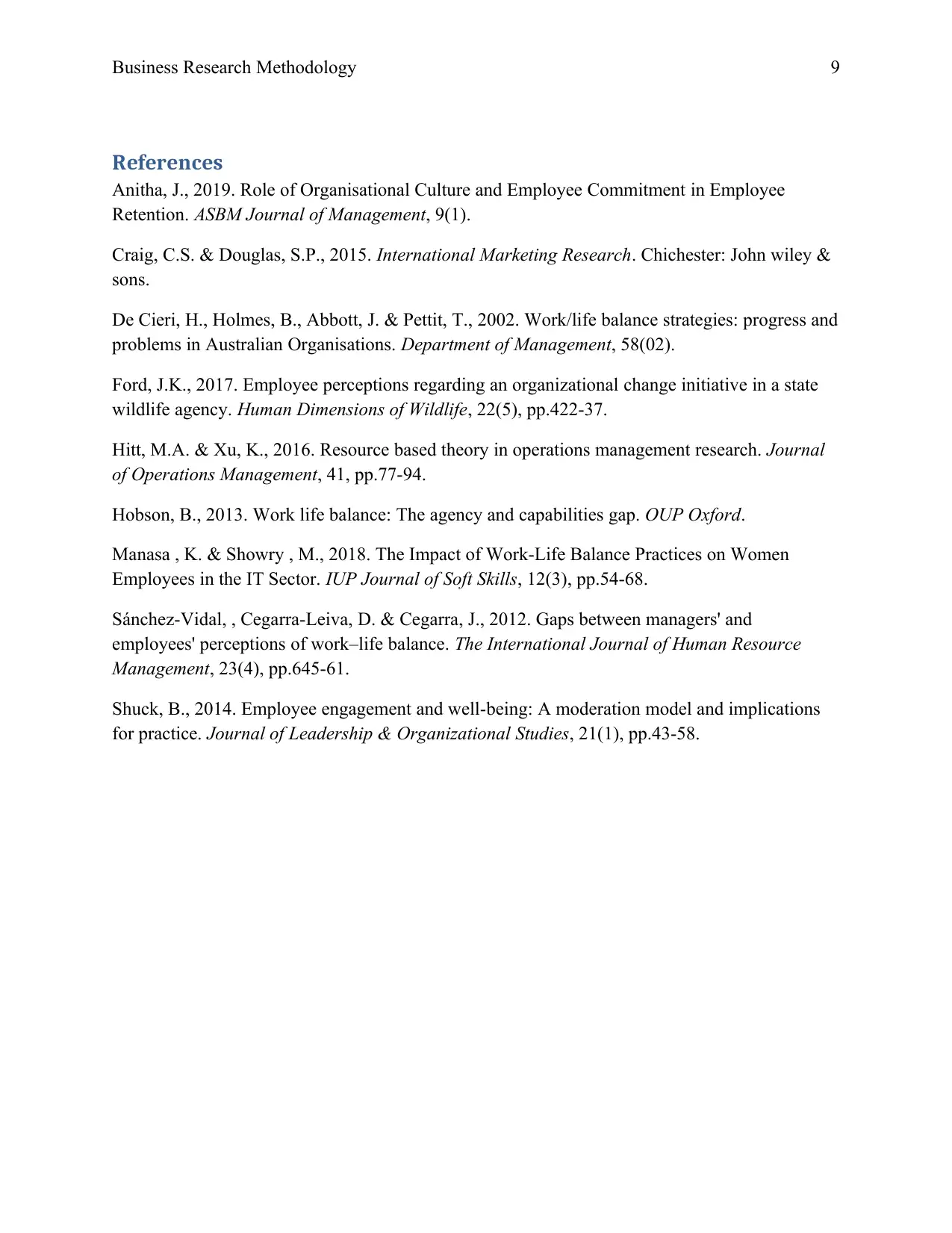
Business Research Methodology 9
References
Anitha, J., 2019. Role of Organisational Culture and Employee Commitment in Employee
Retention. ASBM Journal of Management, 9(1).
Craig, C.S. & Douglas, S.P., 2015. International Marketing Research. Chichester: John wiley &
sons.
De Cieri, H., Holmes, B., Abbott, J. & Pettit, T., 2002. Work/life balance strategies: progress and
problems in Australian Organisations. Department of Management, 58(02).
Ford, J.K., 2017. Employee perceptions regarding an organizational change initiative in a state
wildlife agency. Human Dimensions of Wildlife, 22(5), pp.422-37.
Hitt, M.A. & Xu, K., 2016. Resource based theory in operations management research. Journal
of Operations Management, 41, pp.77-94.
Hobson, B., 2013. Work life balance: The agency and capabilities gap. OUP Oxford.
Manasa , K. & Showry , M., 2018. The Impact of Work-Life Balance Practices on Women
Employees in the IT Sector. IUP Journal of Soft Skills, 12(3), pp.54-68.
Sánchez-Vidal, , Cegarra-Leiva, D. & Cegarra, J., 2012. Gaps between managers' and
employees' perceptions of work–life balance. The International Journal of Human Resource
Management, 23(4), pp.645-61.
Shuck, B., 2014. Employee engagement and well-being: A moderation model and implications
for practice. Journal of Leadership & Organizational Studies, 21(1), pp.43-58.
References
Anitha, J., 2019. Role of Organisational Culture and Employee Commitment in Employee
Retention. ASBM Journal of Management, 9(1).
Craig, C.S. & Douglas, S.P., 2015. International Marketing Research. Chichester: John wiley &
sons.
De Cieri, H., Holmes, B., Abbott, J. & Pettit, T., 2002. Work/life balance strategies: progress and
problems in Australian Organisations. Department of Management, 58(02).
Ford, J.K., 2017. Employee perceptions regarding an organizational change initiative in a state
wildlife agency. Human Dimensions of Wildlife, 22(5), pp.422-37.
Hitt, M.A. & Xu, K., 2016. Resource based theory in operations management research. Journal
of Operations Management, 41, pp.77-94.
Hobson, B., 2013. Work life balance: The agency and capabilities gap. OUP Oxford.
Manasa , K. & Showry , M., 2018. The Impact of Work-Life Balance Practices on Women
Employees in the IT Sector. IUP Journal of Soft Skills, 12(3), pp.54-68.
Sánchez-Vidal, , Cegarra-Leiva, D. & Cegarra, J., 2012. Gaps between managers' and
employees' perceptions of work–life balance. The International Journal of Human Resource
Management, 23(4), pp.645-61.
Shuck, B., 2014. Employee engagement and well-being: A moderation model and implications
for practice. Journal of Leadership & Organizational Studies, 21(1), pp.43-58.
1 out of 10
Related Documents
Your All-in-One AI-Powered Toolkit for Academic Success.
+13062052269
info@desklib.com
Available 24*7 on WhatsApp / Email
![[object Object]](/_next/static/media/star-bottom.7253800d.svg)
Unlock your academic potential
Copyright © 2020–2025 A2Z Services. All Rights Reserved. Developed and managed by ZUCOL.





